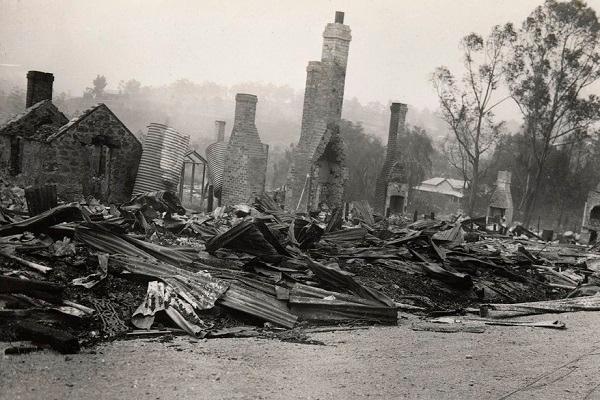The ferocity of the January 1939 bushfires was unlike anything Victoria had ever experienced at the time, claiming 71 lives and 2 million hectares of land. The infernos had a momentous impact on Victoria’s management of fire, leading to the establishment of the CFA.

Several years of drought conditions across Melbourne and a dry hot summer set the foundations for disastrous fires that erupted across Victoria in January 1939, devastating much of the State.
High temperatures and strong winds fanned several fires, some of which had been burning since early December, into a massive fire front which culminated on 13 January (Black Friday).
Temperatures on this day reached 44 degrees in Melbourne and 47 degrees in Mildura with a north-westerly wind gusting up to 60km/hour. The conditions fed major fires in the alpine area, Portland, Otway Ranges, Grampians and the Strzelecki Ranges in West Gippsland, plus many smaller fires. By this time, close to three quarters of the State was affected by fire in some way.
The bone-dry conditions were the perfect kindling for fires to take hold, combined with the careless contributions of many landowners, forestry workers and campers who lit or left fires unattended in the lead up to 13 January. These fires were unable to be controlled in the severe conditions, which lead to them spread out of control.
- 8 January - Two people die in Toolangi State Forest.
- 9 January – Fires burn in Woodend, Mt Macedon, Dromana, Arthurs Seat, Frankston, Dandenong Ranges, Cockatoo, Noojee, Moe, Yallourn, Bairnsdale, Harrietville, Mt Bogong and Orbost.
- 10 January - Great Dividing Range forests under attack. Large fires break out at Erica and Powelltown.
- 13 January – Black Friday – Fires destroy Narbethong, Noojee, Woods Point, Nayook West and Hill End. At the Matlock Sawmill settlement, 15 people die trying to escape fires.
Loses and devastation
The fires claimed 36 lives in Victoria on Black Friday alone, with a total number of 71 deaths across January. Thousands of sheep, cattle and horses and countless wildlife were killed by intense heat and flames that scorched over 2 million hectares across Victoria, destroying great swathes of State Forest and Crown land, including giant Mountain Ash.
The towns of Narbethong, Noojee, Woods Point, Nayook West and Hill End were completely destroyed by the fires. 1300 buildings were lost, including more than 700 homes, 69 sawmills, many businesses and farms.
Townships of Warrandyte, Yarra Glen, Omeo and Pomonal were damaged along with the Black Range, Rubicon, Acheron, Tanjil Bren, Matlock, Erica, Omeo, Toombullup and the Black Forest.
Intense fires burned the urban fringe of Melbourne in the Yarra Ranges east of Melbourne, affecting towns including Toolangi, Warburton and Thomson Valley.
As rain fell across the state on Sunday, 15 January, the fires which had raged so violently for over a fortnight had come to an end.
Foundations of CFA
A Royal Commission for the Black Friday bushfires played a significant role in improving our bushfire awareness and its findings still inform the way Victoria’s fire management practices of today.
Importantly, the commission recommended a clear separation of fire and forest management on public and private land, and better cooperation between government departments and firefighting agencies.
A single firefighting authority for country Victoria, bringing together the Bush Fire Brigades, Country Fire Brigades and Forest Commission, is a key recommendation. On 2 April 1945, the Country Fire Authority (CFA) was born.
The 1939 fires prompted the establishment of three firefighting agencies for Victoria
- The CFA, formed to manage fire on private land outside greater Melbourne.
- Metropolitan Fire Brigade (now Fire Rescue Victoria) protecting inner and greater Melbourne
- The Forests Commission (now Forest Fire Management Victoria) to take complete control of fire suppression and prevention on public land in Victoria.
Page last updated: Wednesday, 20 September 2023 4:08:21 PM